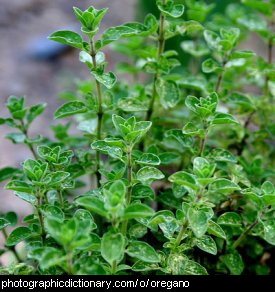Scientific name: cuminum cyminum
Scientific name: anethum graveolens
Dill is a feathery herb that can grow up to a metre tall. It can be grown easily from seed in spring and summer. It grows so easily from seed that once you have a dill plant go to seed once you will have dill everywhere!
Dill can be used in lots of different types of cooking but goes best with fish and potatoes. The fresh leaves are usually used, cut up finely and sprinkled over food.
Scientific name: foeniculum vulgare
Scientific name: allium sativum
Garlic is a member of the onion family. Garlic is used as a seasoning in many different varieties of food. Garlic is very strong and can make your breath smell bad the day after you eat it. The bulb of the garlic is usually made of several different sections called cloves that can be pulled apart and peeled individually.
It was once thought that garlic warded off vampires.
Scientific name: zingiber officinale
Ginger is a root which is used in cooking. It is used to make gingerbread men, in gravies, stir-fries, curries and cakes. It has a strong, sharp taste.
It can be used as a medicine too, particularly for easing morning sickness, or to aid digestion.
Scientific name: family: mentha
Mint is a family of small plants with a strong taste and smell. It is used most often to make tea, jellies and sweets or candy. Most chewing gums, toothpastes and breath fresheners are mint flavoured. Fresh mint can be added to drinks, salads or as a garnish on many meals. Mint is often used in sweets, biscuits or cookies along with chocolate. The leaves of the mint are used for their flavour, either fresh or dried. The flavour is carried in oil in the leaves, and the very strongly flavoured oil can be extracted and stored for later use.
Mint is an easy plant to grow. It prefers a lightly shaded spot with good, moist soil but will grow almost anywhere under almost any conditions. It grows a vigorous root system that can spread very fast. Mint is best grown in a pot so it doesn't invade the rest of the garden. You can grow new mint plants by taking a cutting of a mint runner. Just digging down a little at the edge of a clump of mint should loosen up a runner that already has roots, and can be clipped off and used to grow a new plant.
Scientific name: sinapis hirta and brassica juncea
There are several different kinds of mustard plant. They are in the same family as canola, turnips and cabbages. A field of mustard flowering looks very much like a field of canola flowering.
Mustard is grown mainly for its seeds, although the leaves can be eaten too. Mustard seeds are ground up and mixed with vinegar and sometimes other spices to make the mustard you can buy in shops. Depending on the type of mustard used, mustard paste can be very sharp or very mild. Sometimes mustard, called wholegrain mustard, is made from the whole seeds of the mustard plant and a little oil instead of crushing the seeds to a paste.
Scientific name: genus: myristica
Nutmeg comes from an evergreen tropical tree native to Indonesia. Nutmeg comes from the nut at the center of the fruit in the picture, while mace is made from the red coating that is found around the outside of the seed.
Nutmeg has a strong, warm taste and is used as a spice by many different cultures, in both sweet and savory dishes.
Scientific name: origanum vulgare
Oragano is a herb often used in Greek, Spanish and Italian cooking. It comes from the Mediterranean region. Oregano is very commonly used on pizza.
Paprika is a spice, usually found as a powder, made from dried and ground up bell peppers (capsicums). Paprika is often smoked to add to the flavour.
Paprika is used to flavour or colour many dishes, and is often sprinkled on meat before it is fried.












